|
|
|
Sort Order |
|
|
|
Items / Page
|
|
|
|
|
|
|
| Srl | Item |
| 1 |
ID:
144356
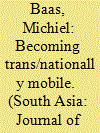

|
|
|
|
|
| Summary/Abstract |
The growth of Indian students' enrolment numbers in Australian educational institutions has often been linked to the relatively easy pathway the country, until recently, offered towards Australian permanent residency (PR). However, building on ethnographic data collected over the past ten years this article shows that ‘permanently’ residing in Australia is often not the objective. Instead, the mobility that these Indian student-migrants aim for encompasses a broader understanding of mobility that includes a variety of locations in both countries and beyond which emerge and/or are abandoned organically in an individual's trajectory. As such it is argue that their mobility strategies can be conceptualized as having ‘trans/national’ dimensions.
|
|
|
|
|
|
|
|
|
|
|
|
|
|
|
|
| 2 |
ID:
117721
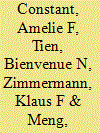

|
|
|
|
|
| Publication |
2013.
|
| Summary/Abstract |
In this paper we provide an overview of China's human capital strategy and educational achievements over the last two decades. While everyone acknowledges China as an economic superpower, very few are aware of or realize China's notable achievements in education as well as its internationalization of education. Since 1978, the landmark for the foundation of the Chinese modern higher education system, China has made tremendous strides in education both domestically and internationally. While China maintains 10% growth in GDP, albeit with a GDP per capita at a low level for a developing country, it is also producing serious scholars and a tremendous amount of scholarly output; more and more Chinese students are seeking higher education abroad; and international students are showing a rising interest in receiving education in China.
|
|
|
|
|
|
|
|
|
|
|
|
|
|
|
|
| 3 |
ID:
092168
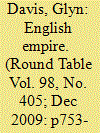

|
|
|
|
|
| Publication |
2009.
|
| Summary/Abstract |
Australia in the 1950s received and subsidised its first international students from neighbouring Asian countries under the Colombo Plan to train 'the expert minds' necessary for development. During the 1980s subsidies were phased out, but the number of international students greatly increased. Migration rules based on points encouraged such students to become skilled migrants. Globalisation brought massive increases in student numbers and competition for revenue from their fees. English-speaking countries have market advantages because of the 'empire' of the United States; but it is dangerous to become over-reliant on overseas fee income. Public funding and curriculum structures need reform.
|
|
|
|
|
|
|
|
|
|
|
|
|
|
|
|
| 4 |
ID:
166630


|
|
|
|
|
| Summary/Abstract |
Each ethnic enclave has its own idiosyncrasies, leading to disagreements as to the functions they serve for the migrants inhabiting them. However, three main functions may be identified across scholarly literature: shielding, economic and cultural. This article explores to what extent the spatial organization of the ethnic enclave is necessary for fulfilling these functions by taking the case of the Chinese international students in a Norwegian town. These students comprise a relatively cohesive group, and their conational social networks serve most of the same purposes of ethnic enclaves without the need for a separate neighbourhood. While most of their material needs are met, the students still express a lack of belonging, a need for a place that is ‘for us’, and they present an example of how an ethnic space is constructed without the need for a traditional ‘Chinatown’.
|
|
|
|
|
|
|
|
|
|
|
|
|
|
|
|
| 5 |
ID:
138415


|
|
|
|
|
| Summary/Abstract |
Recent years have seen the emergence of an international market for higher education. It is likely that the number of international students worldwide may have reached 5.2 million in 2014, with these students responsible for expenditures for tuition, accommodation, and other living expenses of no less than $50 billion. Since 1970, the number of international students is estimated to have doubled every fifteen years, on average, and the pace may be accelerating because of the expanding pool of tertiary education graduates in emerging economies where more education suppliers are entering the market. Experts predict that there will be at least 8 million international students by market. 2025, a larger group than the total population of Switzerland, Norway, or Ireland. This article traces the growth of student migration to the Cold War period when it was driven largely by the competition between the Soviet bloc and the West for influence in the developing world, how it has since been transformed (and now is being driven mainly by competition for dominance in technological innovation and trade), and concludes with questions on what it means for the less-developed countries of origin.
|
|
|
|
|
|
|
|
|
|
|
|
|
|
|
|
| 6 |
ID:
134167
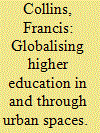

|
|
|
|
|
| Publication |
2014.
|
| Summary/Abstract |
This paper explores the connections between universities and cities in a moment of heightened emphasis on international student mobilities and globalising processes in Asian higher education. In particular, I seek to draw attention to the contingent assembly of the urban and its role in globalising higher education by highlighting the ways in which urban spaces draw together different sorts of trans-local connections and flows. To explore this approach, I discuss the globalisation of higher education in South Korea, and the significance of Seoul in these processes through a focus on two leading universities - Korea University and Seoul National University. To highlight the importance of trans-local connections in the urban dimensions of higher education, I discuss the generation of desires to be mobile in imaginations of Seoul as a destination for higher education, student experiences of situated learning in place and the articulation of student mobilities into career pathways with Korean transnational firms. From this perspective urban spaces need to be understood as much more than just the geographical backdrop to the globalisation of higher education. Rather, cities like Seoul are the spaces through which connections are being forged around knowledge production, international migration and trans-local economic practices.
|
|
|
|
|
|
|
|
|
|
|
|
|
|
|
|
| 7 |
ID:
167843
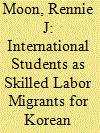

|
|
|
|
|
| Summary/Abstract |
This study examines international students in Korea as skilled labor migrants, specifically for small and medium-sized enterprises. It suggests that strengthening the study–work pathway as in other advanced countries represents a viable, future-oriented strategy in addressing the complications associated with hiring foreigners from abroad.
|
|
|
|
|
|
|
|
|
|
|
|
|
|
|
|
| 8 |
ID:
190921
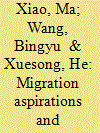

|
|
|
|
|
| Summary/Abstract |
Drawing on longitudinal research with 33 Chinese international students in 10 European countries, this article examines their polymorphic identifications towards homeland and asks how these changing perceptions constitute the underlying logic of their particular migration aspirations during the COVID-19. Specifically, the article explores how homeland identifications function as a driving force to facilitate ‘voluntary immobility’ in the study destination while being used as a tackling strategy to adapt to their ‘involuntary immobility’ overseas. It also examines how these identifications articulate with the students’ mixing and shifting migration aspirations formulated during the pandemic. In doing so, the article demonstrates that polymorphic perceptions closely relate to the generation, exercise and reproduction of their migration aspirations that are temporally distributed.
|
|
|
|
|
|
|
|
|
|
|
|
|
|
|
|
| 9 |
ID:
160268
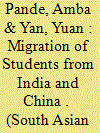

|
|
|
|
|
| Summary/Abstract |
India and China send out the largest number of students for education abroad. To amplify the point, between the years 2000 and 2014, the number of students going out from China increased about twelve times, while it increased about four times from India. This outflow has become a major source of brain and capital drain for both countries. Although, both Push and Pull factors contribute to this massive exodus, each country has adopted separate strategies to address this issue. China opened up its education sector and as a result is gradually emerging as a major hub for education; India on the other hand adopted a rather inward looking approach for a long time and is still grappling with some basic issues in its education sector. Consequently, it is yet to make its education sector competitive and attract foreign students in large numbers despite having some inherent advantages.
|
|
|
|
|
|
|
|
|
|
|
|
|
|
|
|
| 10 |
ID:
185499


|
|
|
|
|
| Summary/Abstract |
This article focuses on the stigmatisation of East Asian students within Western universities. This is necessary because East Asian students are often overlooked in existing literature about racism in Western academia. It is argued that East Asian students may be generalised as undesirable students in ways that resonate with more broadly held prejudices about East Asian people. To illustrate this, academic publications about East Asian students are critiqued. This involves identifying, analysing and deconstructing the stereotypes of East Asian students which inadvertently totalise them as homogenous, inadequate and deficient. More specifically, it is argued that East Asian students are often unfairly depicted as: a) lacking critical thinking skills; b) being prone to plagiarism; and c) harming the educational environment. This article introduces the notion of ‘the myth of academic tolerance’ and calls upon academics and universities to actively resist the stigmatisation of East Asian students.
|
|
|
|
|
|
|
|
|
|
|
|
|
|
|
|
| 11 |
ID:
110230
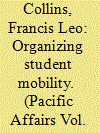

|
|
|
|
|
| Publication |
2012.
|
| Summary/Abstract |
The movement of international students represents an increasing component of contemporary population mobilities. Like other forms of migration, international student mobility takes place through a complex assemblage of actors and networks, including origin and destination states, educational institutions, families, friends and communities, and of course students themselves. In the midst of these arrangements education agents appear to occupy a pivotal position, serving as a bridge between student origins and study destinations in a manner that enables multiple movements across educational and geographic divides. Establishing and maintaining this important position in international student mobilities is a complex endeavour that requires agents to bridge the gap between a solely profit-oriented education industry and the social lives of students and their families. This paper investigates the position of agents in student mobilities by focusing on the development of export education activities since the early 1990s in New Zealand and the changing relationships of agents with the state, education providers and students. I trace the emergence of agents to the early liberalization of student mobility and educational provision but also note how agents became increasingly incorporated into a more formalized education industry as later governments engaged in more direct intervention and regulation of student flows and educational quality. To broaden this general overview of the role of agents the paper focuses on the specific activities and relationships of agents involved in the movement of South Korean international students. The paper concludes by highlighting the need for research on agents and other intermediaries to focus in more detail on the manner in which these actors mediate different sorts of relationships, between migration/education industries and migrant/student social networks as well as between changing state liberalization and intervention and emerging industry formations.
|
|
|
|
|
|
|
|
|
|
|
|
|
|
|
|
| 12 |
ID:
134161
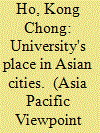

|
|
|
|
|
| Publication |
2014.
|
| Summary/Abstract |
This paper highlights the relationship between the largest cities in East Asia and the comprehensive research universities that are located there. We look at three strands in this relationship. The first involves students and their perception of host cities, which provides a better understanding of student life and how this connects to the social-cultural environment of the city. The second strand examines the relationship between the university and industry, showing how such collaborations represent university products and knowledge spillovers that connect the university to the metropolitan economy. By examining where students plan to go after graduation, the third strand indicates that the city not only receives student migrants studying in metropolitan universities, it also receives graduates from other East Asian universities. Such third country choices (not returning home or staying in the host country) suggest a new after-study mobility and a small but growing pool of students who are likely to remain in East Asia's largest cities after graduation.
|
|
|
|
|
|
|
|
|
|
|
|
|
|
|
|
|
|
|
|
|